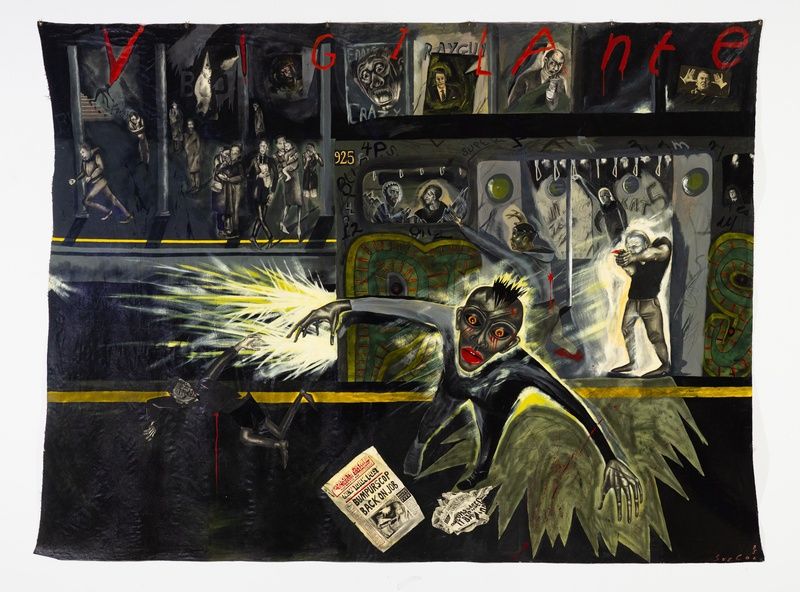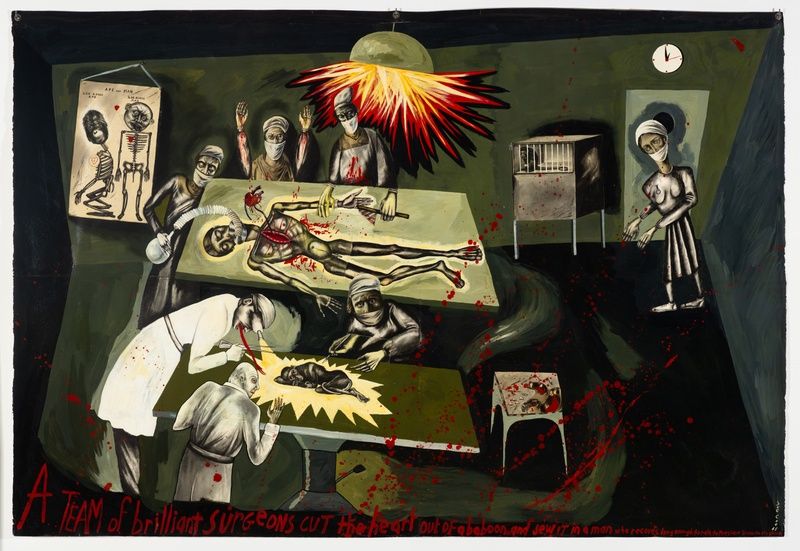James Fuentes Gallery
Sue Coe
Sue Coe: Paintings
Sue Coe is a British-American artist and activist working across drawing, printmaking, and painting. Coe studied at the Royal College of Art in London and emigrated to the US in the early 1970s, where she lived in New York City until upstate New York in 2002. Coe is known for her striking, propaganda-like visual commentary on major events and figures in culture and politics, rendered in stark visual contrast through her highly recognizable palette of black, white, and red. Coe’s experience growing up in close proximity to a slaughterhouse informed her lifelong animal rights activism, which remains interconnected within both her wider political activism and her output as an artist. In the decades since, Coe’s work has focused on factory farming, sweat shops, reproductive rights, housing, the prison system, war, the AIDS crisis, and the South African apartheid, often through depictions of key events and dates as marked by their presence in mass media. As well as being presented in museum and gallery exhibitions internationally, Coe’s graphic work has also been regularly published in periodicals like The New York Times, The New Yorker, Time Magazine, Newsweek, and others, delivering her powerful commentary on as a broad a basis as possible.
Spanning the 1980s, the mixed-media paintings on view hone in on a series of pivotal events. It was during this decade that Coe emerged as a major force on the East Village art scene, turning her attention away from commissioned illustration to address pressing social issues on a wider scale. United visually by a common backdrop of dark black, the imagery seems to emerge from darkness—figuratively and metaphorically. Coe renders these scenes with a material immediacy, prompting an undeniably visceral and emotional response, so as to remain with the viewer long after one’s first encounter with the work. In Coe’s words, this moment ”…is like a tiny thimble full of truth—a tiny speck. But that speck is very dangerous […] One little bit of truth can spread on the oily waters.” The paintings on view depict the violence of the Police State (1986) through various iterations, from the menacing confrontation of a Traffic Violation (1986) to that of an eviction in Landlord Says No to Children (1985), to the threat of civilian-enacted policing shown in Vigilante (1985) and Baby Killers (1985). Coe’s frightful depiction of an inter-species organ transplant in Baboon Heart Transplant (1985) speaks more directly to the artist’s long-term animal rights advocacy (this work was also featured in the exhibition, Sue Coe: Graphic Resistance, presented at MoMA PS1 in 2018). While centering on an early decade in Coe’s career, this exhibition seeks to emphasize the powerful timelines inherent to Coe’s works, including their persistence today on a personal and individual level, as well as their renewed relevance on an international scale.
Sue Coe (b. 1951, Staffordshire, England) has been exhibited at venues including the Museum of Modern Art, New York; The Drawing Center, New York; National Museum of Women in the Arts, Washington DC; San Francisco Museum of Modern Art; Wexner Center for the Arts, Columbus OH; Andy Warhol Museum, Pittsburgh PA; and Pompidou Center, Paris. Coe’s works are included in the public collections of The Museum of Modern Art, Whitney Museum, The Metropolitan Museum of Art, Cooper-Hewitt Museum, Brooklyn Museum, Smithsonian American Art Museum, Pennsylvania Academy of the Fine Arts, Walker Art Center, Art Institute of Chicago, Harvard Art Museums, Birmingham Museum of Art, The Museum of Fine Arts Houston, Stedelijk Museum Amsterdam, among others. In 2018, MoMA PS1 presented Sue Coe: Graphic Resistance.
James Fuentes Essex is a temporary off-site exhibition series held at 81 Essex St. James Fuentes will concurrently be exhibiting Lui Shtini, Ruminations (May 12–June 13) at 55 Delancey St.
Works

It's Not Safe, 1983
Mixed media and collage on paper and canvas
83 ½ × 120 inches

Vigilante, 1985
Mixed media and collage on canvas
96 × 120 inches

Needs of the State, 1987
Oil and mixed media on paper
92 3/4 × 60 ¼ inches

Baboon Heart Transplant, 1985
Mixed media, oil, collage on paper and canvas
52 × 77 inches